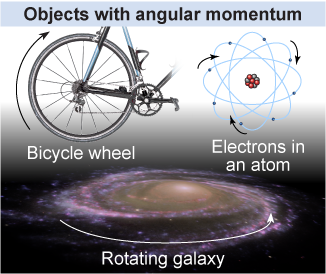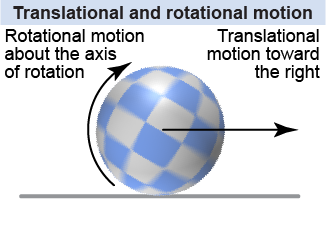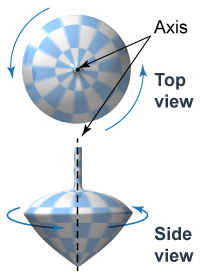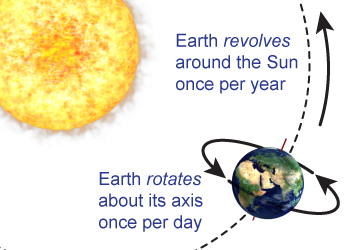|
 Spinning objects tend to keep spinning for the same reason moving objects tend to keep moving with the same speed and direction. A spinning bicycle wheel has angular momentum as a result of its rotational motion. Angular momentum resists changes in rotational speed or orientation, similar to the way linear momentum resists changes in linear speed or direction. If you spin a heavier wheel at the same speed, or spin the same wheel faster, it will have more angular momentum and be more difficult to stop or turn. Angular momentum plays a key role in the behavior of objects from the smallest microscopic scale inside the atom to the largest macroscopic scales in the dynamics of the Solar System and the Milky Way Galaxy.
Spinning objects tend to keep spinning for the same reason moving objects tend to keep moving with the same speed and direction. A spinning bicycle wheel has angular momentum as a result of its rotational motion. Angular momentum resists changes in rotational speed or orientation, similar to the way linear momentum resists changes in linear speed or direction. If you spin a heavier wheel at the same speed, or spin the same wheel faster, it will have more angular momentum and be more difficult to stop or turn. Angular momentum plays a key role in the behavior of objects from the smallest microscopic scale inside the atom to the largest macroscopic scales in the dynamics of the Solar System and the Milky Way Galaxy. 
|
Describing rotational motion
|
 Objects may move from one place to another while they are simultaneously rotating. A good example is a rolling ball. The ball has translational motion that takes it across the floor. Translation is a type of motion that causes a change in position. While the ball is translating it is also rotating. When we analyze complex motion we may treat translational and rotational motions independently and associate momentum and energy with each.
Objects may move from one place to another while they are simultaneously rotating. A good example is a rolling ball. The ball has translational motion that takes it across the floor. Translation is a type of motion that causes a change in position. While the ball is translating it is also rotating. When we analyze complex motion we may treat translational and rotational motions independently and associate momentum and energy with each. 
 |
In addition to rotational and translational motion, there is a third type of motion: oscillatory or harmonic motion. A pendulum or swing moves back and forth through oscillatory motion. We will learn more about oscillatory motion in the next chapter!
Deformation is sometimes referred to as a fourth type of motion. Deformation can occur, for example, through twisting, stretching, bending, or compressing a material. The elastic deformation of a solid is described through Hooke’s law. 
|
The axis of rotation is an imaginary line around which rotation occurs. A spinning top rotates about a vertical axis—a straight line—passing through the center of the top. The axis of rotation for a bicycle wheel is the axle of the wheel, which is horizontal when the bicycle is being ridden. 
| 
|
Many properties of rotational motion, such as angular momentum, depend on the location and orientation of the axis of rotation. The same object rotated around a different axis will have different rotational kinetic energy and angular momentum, even if the mass and rotational speed stay the same! 
|
 A rotation describes a motion in which the axis lies within the object, such as the motion of the spinning top or bicycle wheel. A revolution refers to a rotational motion about an axis that is outside the object. As an example, Earth undergoes both rotation and revolution. Earth makes a full rotation about its north–south axis every 24 hours, creating day and night. Earth makes a full revolution (orbit) around the Sun once per year. The axis of Earth’s orbital motion passes through the Sun and is perpendicular to the plane of the Solar System.
A rotation describes a motion in which the axis lies within the object, such as the motion of the spinning top or bicycle wheel. A revolution refers to a rotational motion about an axis that is outside the object. As an example, Earth undergoes both rotation and revolution. Earth makes a full rotation about its north–south axis every 24 hours, creating day and night. Earth makes a full revolution (orbit) around the Sun once per year. The axis of Earth’s orbital motion passes through the Sun and is perpendicular to the plane of the Solar System. 
|
Does the Moon rotate or revolve every lunar month?
 |
Both! Every lunar month, the Moon revolves once around the Earth. During every lunar month, the Moon also rotates exactly once about its axis.
The side of the Moon facing the Earth is tidally locked so that it always faces the Earth; we can never see the far side of the Moon from the Earth’s surface. So one rotation of the Moon takes the same time as one revolution of the Moon about the Earth. 
|
What kind of motion occurs when - you ride a bicycle down the street?
- you mount the bicycle on a repair stand and spin the rear wheel?
- a ball skids across the floor?
 |
- Both translational and rotational motion occur. You travel down the street, which is translational motion. The bicycle wheels rotate about their axles, which is rotational motion.
- Only rotational motion occurs. The rear wheels rotate about its axle, but the bicycle does not move to a different location—because it is mounted on a repair stand!
- Only translational motion occurs. The ball is skidding, not rolling, so it is not undergoing rotational motion.

|

